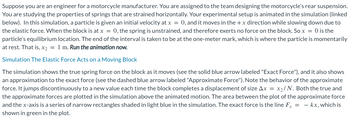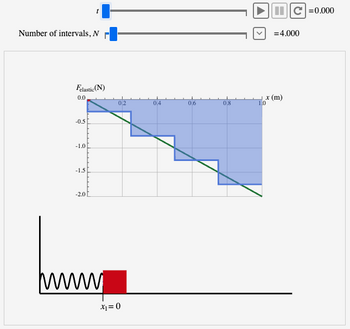
College Physics
11th Edition
ISBN: 9781305952300
Author: Raymond A. Serway, Chris Vuille
Publisher: Cengage Learning
expand_more
expand_more
format_list_bulleted
Concept explainers
Question
Using the geometrical approach based on areas just described in question 1, you can find the total work done by the approximate force over the displacement between x = 0 and x = x2. What is this approximate work for the case of N = 4?

Transcribed Image Text:Suppose you are an engineer for a motorcycle manufacturer. You are assigned to the team designing the motorcycle's rear suspension.
You are studying the properties of springs that are strained horizontally. Your experimental setup is animated in the simulation (linked
below). In this simulation, a particle is given an initial velocity at x = 0, and it moves in the + x direction while slowing down due to
the elastic force. When the block is at x = 0, the spring is unstrained, and therefore exerts no force on the block. So x = 0 is the
particle's equilibrium location. The end of the interval is taken to be at the one-meter mark, which is where the particle is momentarily
at rest. That is, x₂ = 1 m. Run the animation now.
Simulation The Elastic Force Acts on a Moving Block
The simulation shows the true spring force on the block as it moves (see the solid blue arrow labeled "Exact Force"), and it also shows
an approximation to the exact force (see the dashed blue arrow labeled "Approximate Force"). Note the behavior of the approximate
force. It jumps discontinuously to a new value each time the block completes a displacement of size Ax = x₂/N. Both the true and
the approximate forces are plotted in the simulation above the animated motion. The area between the plot of the approximate force
and the x-axis is a series of narrow rectangles shaded in light blue in the simulation. The exact force is the line Fx = = kx, which is
shown in green in the plot.

Transcribed Image Text:Number of intervals, N
Felastic (N)
0.0
-0.5
-1.0
-1.5
-2.0
www.
02
x₁ = 0
0.4
0.6
0.8
x (m)
1.0
C=0.000
= 4.000
Expert Solution
This question has been solved!
Explore an expertly crafted, step-by-step solution for a thorough understanding of key concepts.
This is a popular solution
Trending nowThis is a popular solution!
Step by stepSolved in 5 steps with 4 images

Knowledge Booster
Learn more about
Need a deep-dive on the concept behind this application? Look no further. Learn more about this topic, physics and related others by exploring similar questions and additional content below.Similar questions
- Calculate the dot product: A ∙ B, given that vectors A = 3i + 6j a nd B = 4i – 4j (use - sign in answer, if neededarrow_forwardIf Force = (- 7, 9) and displacement = (-2,-2 ), find the work done from the two vector measurements .arrow_forwardFind the work (in J) done by the force F (6 N/m)yî + (27 N/m)xĵ between the points A = (0, 0) and B = (2 m, 2 m) over a circular arc of radius 2 m, centered at (0, 2 m). Evaluate the path integr %3D using Cartesian coordinates. (Hint: You will probably need to consult a table of integrals.) y(m)4 (2, 2) F(x, y) (0, 0) x(m)arrow_forward
- Hey I am stuck on this question my potential function is f(x,y,z) = c/(Sqrt(x^2 + y^2 + z^2) and I got W = c/d2 - c/d1 but that is wrong.arrow_forwardWhat is the dot product A•B if A = 2x - 3y and B = 15x + 10y?arrow_forwardA spring with k = 15 N/m with equilibrium length 30 cm is attached vertically to a surface and then allowed to come to equilibrium, after which a weight with mass 0.2 kg is attached to the top side of the spring. → How much work does the Earth do on the weight via gravity between its initial position and the new equilibrium height? Explicitly compute the work with an integral.arrow_forward
- A child of mass m = 16 kg slides down a slide of height h = 2.7 m without friction. Let gravitational potential energy be zero at ground level. a)Write an expression for the child's total mechanical energy, E, at the top of the slide, in terms of the variables in the problem and the acceleration due to gravity g. b)Calculate the change in the child's potential energy, ΔU in joules, from the top to the bottom of the slide at ground level (i.e. ΔU = Uground - Utop). c)What is the child's final speed, vf in m/s?arrow_forwardA person is 170 cm tall. He holds a 10 kg object on his head for 10 minutes. How much work is done on the object?arrow_forwardHow did you solve D? Wouldn't it's distance be different from that of Point 1 to Point 2 as would be Point 3 to Point 2 and shouldn't that effect the answer for work needed to be done?arrow_forward
- Needs Complete typed solution with 100 % accuracy.arrow_forwardGiven a vector field F=2xi+3xyj that represents the force of the wind on a sailboat, what is the work done by the wind on a boat traveling along a path defined by y=x^2 from a position (1,1) to a position (5,25)? Assume positions are given in kilometers and that force is in newtons. Note: To make units easy, a newton times a meter is a joule. A newton times a kilometer is a kilojoule (kJ). But F returns newtons.arrow_forwardWhat external work is necessary to bring at constant speed, from infinity, four point loads of 2nC to the four corners of a square with an edge measuring 0.14m? Answer: 1.39uJ Please show steps, explanation and formulas for my own understanding. Thankyouarrow_forward
arrow_back_ios
arrow_forward_ios
Recommended textbooks for you
 College PhysicsPhysicsISBN:9781305952300Author:Raymond A. Serway, Chris VuillePublisher:Cengage Learning
College PhysicsPhysicsISBN:9781305952300Author:Raymond A. Serway, Chris VuillePublisher:Cengage Learning University Physics (14th Edition)PhysicsISBN:9780133969290Author:Hugh D. Young, Roger A. FreedmanPublisher:PEARSON
University Physics (14th Edition)PhysicsISBN:9780133969290Author:Hugh D. Young, Roger A. FreedmanPublisher:PEARSON Introduction To Quantum MechanicsPhysicsISBN:9781107189638Author:Griffiths, David J., Schroeter, Darrell F.Publisher:Cambridge University Press
Introduction To Quantum MechanicsPhysicsISBN:9781107189638Author:Griffiths, David J., Schroeter, Darrell F.Publisher:Cambridge University Press Physics for Scientists and EngineersPhysicsISBN:9781337553278Author:Raymond A. Serway, John W. JewettPublisher:Cengage Learning
Physics for Scientists and EngineersPhysicsISBN:9781337553278Author:Raymond A. Serway, John W. JewettPublisher:Cengage Learning Lecture- Tutorials for Introductory AstronomyPhysicsISBN:9780321820464Author:Edward E. Prather, Tim P. Slater, Jeff P. Adams, Gina BrissendenPublisher:Addison-Wesley
Lecture- Tutorials for Introductory AstronomyPhysicsISBN:9780321820464Author:Edward E. Prather, Tim P. Slater, Jeff P. Adams, Gina BrissendenPublisher:Addison-Wesley College Physics: A Strategic Approach (4th Editio...PhysicsISBN:9780134609034Author:Randall D. Knight (Professor Emeritus), Brian Jones, Stuart FieldPublisher:PEARSON
College Physics: A Strategic Approach (4th Editio...PhysicsISBN:9780134609034Author:Randall D. Knight (Professor Emeritus), Brian Jones, Stuart FieldPublisher:PEARSON

College Physics
Physics
ISBN:9781305952300
Author:Raymond A. Serway, Chris Vuille
Publisher:Cengage Learning

University Physics (14th Edition)
Physics
ISBN:9780133969290
Author:Hugh D. Young, Roger A. Freedman
Publisher:PEARSON

Introduction To Quantum Mechanics
Physics
ISBN:9781107189638
Author:Griffiths, David J., Schroeter, Darrell F.
Publisher:Cambridge University Press

Physics for Scientists and Engineers
Physics
ISBN:9781337553278
Author:Raymond A. Serway, John W. Jewett
Publisher:Cengage Learning

Lecture- Tutorials for Introductory Astronomy
Physics
ISBN:9780321820464
Author:Edward E. Prather, Tim P. Slater, Jeff P. Adams, Gina Brissenden
Publisher:Addison-Wesley

College Physics: A Strategic Approach (4th Editio...
Physics
ISBN:9780134609034
Author:Randall D. Knight (Professor Emeritus), Brian Jones, Stuart Field
Publisher:PEARSON